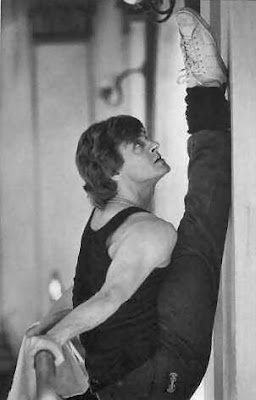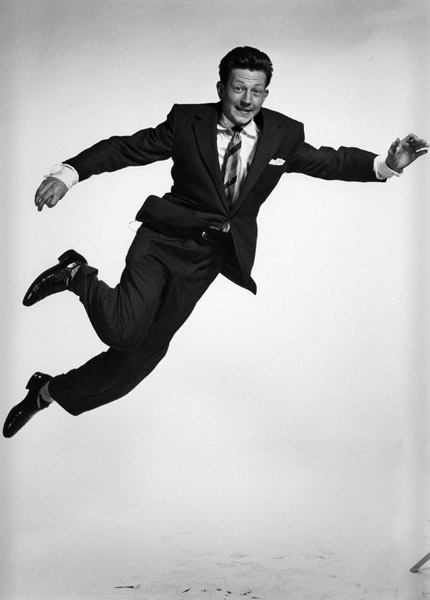Happy Friday Everyone!
Paper is not dead!
The Best Flash Mob EVER!
The star of Mission Impossible Five: Operation Nut Job
Best ways of describing life….


This is just AWESOME!

Paper is not dead!
The Best Flash Mob EVER!
The star of Mission Impossible Five: Operation Nut Job
Best ways of describing life….


This is just AWESOME!


No one is born a dancer.You have to want it more than anything.
Baryshnikov was born in Riga, Latvia, then occupied and annexed by the Soviet Union. His parents were Russian, Alexandra (a dressmaker; maiden name, Kisselova) and Nicholai Baryshnikov (an engineer). Baryshnikov began his ballet studies in Riga in 1960. In 1964, he entered the Vaganova School, in what was then Leningrad (now St. Petersburg). Baryshnikov soon won the top prize in the junior division of the Varna International Ballet Competition. He joined the Kirov Ballet and Mariinsky Theater in 1967, dancing the “Peasant” pas de deux in Giselle.
Recognizing Baryshnikov’s talent, in particular the strength of his stage presence and purity of his classical technique, several Soviet choreographers, including Oleg Vinogradov, Konstantin Sergeyev, Igor Tchernichov, and Leonid Jakobson, choreographed ballets for him. Baryshnikov made signature roles of Jakobson’s 1969 Vestris along with an intensely emotional Albrecht in Giselle. While still in the Soviet Union, he was called by New York Times critic Clive Barnes “the most perfect dancer I have ever seen.”
On June 29, 1974, while on tour in Canada with the Kirov Ballet, Baryshnikov defected, requesting political asylum in Toronto, and joined the Royal Winnipeg Ballet. He also announced to the dance world he would not go back to the U.S.S.R. He later stated that Christina Berlin, an American friend of his, helped engineer his defection during his 1970 tour of London. His first televised performance after coming out of temporary seclusion in Canada was with the National Ballet of Canada in La Sylphide. He then went on to the United States.
From 1974 to 1978, he was principal dancer with the American Ballet Theatre (ABT), where he partnered with Gelsey Kirkland. He also worked with the New York City Ballet, with George Balanchine and as a regular guest artist with the Royal Ballet. He also toured with ballet and modern dance companies around the world for fifteen months. Several roles were created for him, including roles Opus 19: The Dreamer (1979), by Jerome Robbins, Rhapsody (1980), by Frederick Ashton, and Other Dances with Natalia Makarova by Jerome Robbins.
He returned to ABT in 1980 as dancer and artistic director, a position he held for a decade. On July 3, 1986, he became a naturalized citizen of the United States. From 1990 to 2002, Baryshnikov was artistic director of the White Oak Dance Project, a touring company he co-founded with Mark Morris. In 2003, he won the Prix Benois de la Danse for lifetime achievement. In 2005 he launched the Baryshnikov Arts Center in New York.
Baryshnikov made his American television dancing debut in 1976, on the PBS program In Performance Live from Wolf Trap. During the Christmas season of 1977, CBS brought his highly acclaimed American Ballet Theatre production of Tchaikovsky’s classic ballet The Nutcracker to television, and it has remained to this day the most popular and most often shown television production of the work, at least in the U.S. In addition to Baryshnikov in the title role, Gelsey Kirkland, Alexander Minz, and many members of the American Ballet Theatre also starred. The production is still shown by some PBS stations. The Baryshnikov version of The Nutcracker is one of only two to be nominated for an Emmy Award. The other one was Mark Morris’ The Hard Nut, Morris’s intentionally exaggerated and satirical version of the ballet.
Baryshnikov also performed in two Emmy-winning television specials, one on ABC and one on CBS, in which he danced to music from Broadway and Hollywood, respectively. During the 1970’s and 1980’s, he appeared many times with American Ballet Theatre on Live from Lincoln Center and Great Performances. Over the years, he has also appeared on several telecasts of the Kennedy Center Honors.
Baryshnikov performed in his first film role soon after arriving in New York. He portrayed the character Yuri Kopeikine, a famous Russian womanizing ballet dancer, in the 1977 film The Turning Point, for which he received an Oscar nomination. He co-starred with Gregory Hines and Isabella Rossellini in the 1985 film White Nights, choreographed by Twyla Tharp; and he was featured in the 1987 film Dancers. On television, in the last season of Sex and the City, he played a Russian artist, Aleksandr Petrovsky, who woos Carrie Bradshaw relentlessly and takes her to Paris. He co-starred in Company Business (1991) with Gene Hackman.
On November 2, 2006, Baryshnikov and chef Alice Waters were featured on an episode of the Sundance Channel’s original series Iconoclasts. The two have a long friendship. They discussed their lifestyles, sources of inspiration, and social projects that make them unique. During the program, Alice Waters visited Baryshnikov’s Arts Center in New York City. The Hell’s Kitchen Dance tour brought him to Berkeley to visit Alice Waters’ restaurant Chez Panisse.
On July 17, 2007, the PBS News Hour with Jim Lehrer featured a profile of Baryshnikov and his Arts Center.
On April 11–21, 2012, Baryshnikov starred in a new play directed by Dmitry Krymov, titled In Paris. The play was presented in the Santa Monica College Performing Arts Center, at the Broad Stage. His co-star was Anna Sinyakina.
His next role was the stage adaptation of Anton Chekhov’s Man in a Case.
Duo Dance from White Nights with Gregory Hines
Albrechts’ variation from Act II of Giselle in 1977.
Mikhail Baryshnikov in White Nights, dancing “Koni” (Horses) by Vysotsky (KGB spy and killer).
Danced with the Kirov Ballet, the American Ballet Theatre and the New York City Ballet.
Was artistic director with ABT and even ran his own class outside of ABT – Mikhail Baryshnikov’s School of Classic Ballet.
Was romantically involved with legendary ballerinas Natalia Makarova and Gelsey Kirkland.
Frequently attended legendary New York disco Studio 54.
Was nominated for Broadway’s 1989 Tony Award as Best Actor (Play) for “Metamorphosis.”
Owner of ballet troupe, “White Oak Dance Project”.
Taught by ballet instructor Bella Kovarsky when he was a child.
Mikhail was a 2000 recipient of the John F. Kennedy Center Honors.
Keone & Mariel Madrid: “Is This Love” by Bob Marley Choreography
Dog sings to crying baby
Hey There Delilah…with a twist

Yep, you know you’ve been there….
While we are not diagnosed with Celiac or any other serious digestive issues, my husband and I are doing an experiment by eliminating gluten from our diet. I have never been one to consume very much of it, but he did and has been experiencing some digestive and allergy issues. To try to restore health back into his life, we are going gluten-free for the next couple of weeks. Hence, the new gluten-free recipe!!
These muffins are not too sweet, in fact my husband said they could use a bit more sugar. I, on the other hand, think they are fine just the way they are, so I will let you and your family make that judgement call.
To make these not too sweet lemon gluten-free poppy-seed muffins you need:
What you do:
Let me know if you know of any other good gluten-free recipes, I would love to try them!
Eat Well. Be Well. Live Well.
——————————————
Jill Wentworth is leading us Wednesday by Wednesday into making better food choices and being more healthful. Tune in every Wednesday to get some great recipes and advice from someone who really knows health. In an effort to fuel her passion to serve as well has enhance the lives of others through their nutritional choices, she started Eat Well SA(San Antonio). Her vision is to educate you on how to incorporate a healthy array of foods into your life. Eat Well is not a diet, nor does it embrace any one specific dietary agenda. She also offers customized programs that are educational and teach you the tools you need to maintain healthy, well balanced eating for your busy lives.


When you’re happy, you don’t count the years
Ginger Rogers was born Virginia Katherine McMath in Independence, Missouri on July 16, 1911. Her mother, known as Lelee, went to Independence to have Ginger away from her husband. She had a baby earlier in their marriage and he allowed the doctor to use forceps and the baby died. She was kidnapped by her father several times until her mother took him to court. Ginger’s mother left her child in the care of her parents while she went in search of a job as a scriptwriter in Hollywood and later to New York City. Mrs. McMath found herself with an income good enough to where she could send for Ginger. Lelee became a Marine in 1918 and was in the publicity department and Ginger went back to her grandparents in Missiouri. During this time her mother met John Rogers. After leaving the Marines they married in May, 1920 in Liberty, Missouri. He was transferred to Dallas and Ginger (who treated him as a father) went too.
Ginger won a Charleston contest in 1925 (age 14) and a 4 week contract on the Interstate circuit. She also appeared in vaudeville acts which she did until she was 17 with her mother by her side to guide her. Now she had discovered true acting. She married in March, 1929, and after several months realized she had made a mistake. She acquired an agent and she did several short films. She went to New York where she appeared in the Broadway production of “Top Speed” which debuted Christmas Day, 1929.
Her first film was in 1929 in A Night in a Dormitory (1930). It was a bit part, but it was a start. Later that year, Ginger appeared, briefly in two more films, A Day of a Man of Affairs (1929) and Campus Sweethearts (1930). For awhile she did both movies and theatre. The following year she began to get better parts in films such as Office Blues (1930) and The Tip-Off (1931). But the movie that enamored her to the public was Gold Diggers of 1933 (1933). She did not have top billing but her beauty and voice was enough to have the public want more. She suggested using a monocle and this also set her apart. One song she popularized in the film was the now famous, “We’re in the Money”. In 1934, she starred with Dick Powell in Twenty Million Sweethearts (1934).
It was a well received film about the popularity of radio. Ginger’s real stardom occurred when she was teamed with Fred Astaire where they were one of the best cinematic couples ever to hit the silver screen. This is where she achieved real stardom. They were first paired in 1933’s Flying Down to Rio (1933) and later in 1935’s Roberta (1935) and Top Hat (1935). Ginger also appeared in some very good comedies such as Bachelor Mother (1939) and 5th Ave Girl (1939) both in 1939. Also that year she appeared with Astaire in The Story of Vernon and Irene Castle (1939). The film made money but was not anywhere successful as they had hoped. After that studio executives at RKO wanted Ginger to strike out on her own. She starred in her final film with Fred Astaire in 1949 in The Barkelys of Broadway replacing Judy Garland after Garland was suspended from MGM due to her tardiness.
She made several dramatic pictures but it was 1940’s Kitty Foyle (1940) that allowed her to shine. Playing a young lady from the wrong side of the tracks, she played the lead role well, so well in fact, that she won an Academy Award for her portrayal. Ginger followed that project with the delightful comedy, Tom Dick and Harry (1941) the following year. It’s a story where she has to choose which of three men she wants to marry. Through the rest of the 1940s and early 1950s she continued to make movies but not near the caliber before World War II. After Oh, Men! Oh, Women! (1957) in 1957, Ginger didn’t appear on the silver screen for seven years. By 1965, she had appeared for the last time in Harlow (1965). Afterward, she appeared on Broadway and other stage plays traveling in Europe, the U.S. and Canada. After 1984, she retired and wrote an autobiography in 1991 entitled, “Ginger, My Story” which is a very good book. On April 25, 1995, Ginger died of natural causes in Rancho Mirage, California. She was 83.
Fred and Ginger- Too Hot to Handle
Ginger Rogers and Lucy Do The Charleston
Fred and Ginger- Bouncing the Blues from The Barkelys of Broadway
Was given the name “Ginger” by her little cousin who couldn’t pronounce “Virginia” correctly.
Sort-of cousin of Rita Hayworth. Ginger’s aunt married Rita’s uncle.
She didn’t drink: she had her very own ice cream soda fountain.
Was Hollywood’s highest paid star of 1942.
Her first teaming with Fred Astaire, Flying Down to Rio (1933), was her 20th film appearance but only Astaire’s second.
A distant cousin of Lucille Ball, according to Lucie Arnaz.
She and Fred Astaire acted in 10 movies together: The Barkleys of Broadway (1949), Carefree (1938), Flying Down to Rio (1933), Follow the Fleet (1936), The Gay Divorcee (1934), Roberta (1935), Shall We Dance (1937), The Story of Vernon and Irene Castle (1939), Swing Time (1936) and Top Hat (1935)
Rogers holds the record for actresses at New York’s prestigious Radio City Music Hall with 23 films for a total of 55 weeks.
One of the celebrities whose picture Anne Frank placed on the wall of her bedroom in the “Secret Annex” while in hiding during the Nazi occupation of Amsterdam, Holland.
Interred at Oakwood Memorial Park, Chatsworth, California, USA, the same cemetery as long-time dancing/acting partner Fred Astaire is located.

20 Words We Owe to Shakespeare ( Forgot one…Green-eyed Monster)!
http://mentalfloss.com/article/48657/20-words-we-owe-william-shakespeare
In Celebration of the new season of Downton Abbey
A Touching Tribute to Chick-Fil-A
10 Famous Movie Misquotes


In the age of busy lives and jammed packed schedules it can be hard to find time to prepare healthy, wholesome meals for you and your family.
I am not usually a fan of convenience, prepared “fast” food, but I have a great product to share with you that will not only make dinner a bit easier, but it will also provide the nourishment from whole, healthy foods that your body needs.
If you are a Texan you are familiar with HEB, the dominant grocery store chain here. They carry some pretty healthy store brand items that are easy to prepare and are well balanced too.
Next time pick up a loaf of this Multi-grain Bread in the freezer isle. It is MULTI-GRAIN and has plenty of fiber and nutrients, thanks to the seeds, including flax.
This is a great staple item to keep in the freezer, preparation is easy, and a wonderful whole grain option. A much better choice than the traditional french loaf bread that is comprised of processed white flour and lacking the fiber and whole grain nutrients to help fuel your body.
Toast a piece and spread some hummus on it, served with chicken and unlimited veggies and you had an awesome well-balanced meal. This loaf is also works great with grilled cheese sandwiches, served along side homemade tomato soup. Yum!
Thanks to this whole grain bread find, I am hopeful that packaged, convenience food is moving in the right direction. Getting healthier, heartier, and full of nutrients.
BE WELL!
 Jill Tarpey is leading us Wednesday by Wednesday into making better food choices and being more healthful. Tune in every Wednesday to get some great recipes and advice from someone who really knows health. In an effort to fuel her passion to serve as well has enhance the lives of others through their nutritional choices, she started Eat Well SA(San Antonio). Her vision is to educate you on how to incorporate a healthy array of foods into your life. Eat Well is not a diet, nor does it embrace any one specific dietary agenda. She also offers customized programs that are educational and teach you the tools you need to maintain healthy, well-balanced eating for your busy lives.
Jill Tarpey is leading us Wednesday by Wednesday into making better food choices and being more healthful. Tune in every Wednesday to get some great recipes and advice from someone who really knows health. In an effort to fuel her passion to serve as well has enhance the lives of others through their nutritional choices, she started Eat Well SA(San Antonio). Her vision is to educate you on how to incorporate a healthy array of foods into your life. Eat Well is not a diet, nor does it embrace any one specific dietary agenda. She also offers customized programs that are educational and teach you the tools you need to maintain healthy, well-balanced eating for your busy lives.

My mother gave me my drive but my father gave me my dreams
Liza Minnelli was born on March 12, 1946, the daughter of Judy Garland and movie director Vincente Minnelli. She was practically raised at MGM studios while her parents worked long hours there and she made her film debut at fourteen months of age in the movie In the Good Old Summertime (1949). Her parents divorced in 1951 and, in 1952, her mother married Sidney Luft, with sister Lorna Luft and brother Joey Luft subsequently being born. Her father, Vincente Minnelli, later married Georgette Magnani, mother of her half-sister Christiane Nina “Tina Nina” Minnelli.
At sixteen, Liza was on her own in New York City, struggling to begin her career in show business. Her first recognition came for the play “Best Foot Forward” which ran for seven months in 1963. A year later, Judy invited Liza to appear with her for a show at the London Paladium. This show sold out immediately and a second night was added to it. Liza’s performance in London was a huge turning point in both her career and her relationship with her mother. The audience absolutely loved Liza and Judy realized that Liza was now an adult with her own career. It was at the Paladium that Liza met her first husband, Peter Allen, a friend of Judy’s.
Liza won a Tony award at age nineteen and was nominated for her first Academy Award at age twenty-three for the role of Pookie Adams in The Sterile Cuckoo (1969). Other dramatic roles followed and, in 1972, she won an Oscar for her performance as Sally Bowles in the movie Cabaret (1972). The seventies were a busy time for Liza. She worked steadily in film, stage and music. She and good friend Halston were regulars at Studio 54, the trendiest disco club in the world. Marriages to filmmaker Jack Haley Jr. and Mark Gero, a sculptor who earned his living in the theater followed. Each marriage ended in divorce.
Over the past years, her career has leaned more towards stage performances and she has a long list of musical albums which she continues to add to. She teamed with Frank Sinatra in his “Duets” CD and Sammy Davis Jr. joined them for a series of concerts and TV shows which were extremely well-received.
She has had to deal with tabloid stories of drug abuse and ill-health and has had a number of high profile stays at drug-rehabilitation clinics. Her hectic schedule may have slowed down in recent years, but she still has a large following of immensely loyal fans who continue to cheer her on.
Liza Minnelli on the Judy Garland Show
Baryshnikov and Minnelli
Stepping Out
Her parents named her after Ira Gershwin’s song “Liza (All the Clouds’ll Roll Away)”
Says her mother gave her a sense of humor
1990: She received the Grammy Legend Award, making her one of the few artists who have won entertainment’s top four awards – the Oscar, the Tony, The Emmy and the Grammy.
Was briefly managed by KISS lead singer/guitarist Gene Simmons in the 1980s.
When she was young she befriended Marilyn Monroe.
Her mother, Judy Garland, and former father-in-law, Jack Haley, starred together in The Wizard of Oz (1939).
She and her mother, Judy Garland, were the first Oscar-nominated mother and daughter.
Godparents were Ira Gershwin and Kay Thompson.
Because Liza constantly traveled with her mother, she spent most of her childhood in hotels. She was the inspiration for the character of “Eloise”, who grew up in the Plaza Hotel. The books were written by Liza’s godmother, Kay Thompson.
While Frank Sinatra’s version of “New York, New York” is played at Yankee Stadium after every Yankee home win, Liza Minnelli’s version is played after every Yankee home loss.
Her favorite modern-day singers are Adele, Michael Bublé, Pink and ‘Lady GaGa’.

Bio-metric key less locks let you unlock or lock your entry door
with just a quick scan of your fingerprint.

Why not decorate cables when you can’t hide them?

Personal Fondue Mugs

Who says there’s no room for a chess board?

Transparent Toaster gives you clear view of bread’s crispiness
(About time!)

Got a small apartment? No problem!
Mini Mexican Pizzas!

Pesto Pasta with Sun Dried Tomatoes and Roasted Asparagus


Broccoli, Ham, and Mozzarella Baked with Eggs Casserole


Um…YUM!


I was born and raised to entertain other people. I’ve heard laughter and applause and known a lot of sorrow. Everything about me is based on show business – I think it will bring me happiness. I hope so.
Though he considered Danville, Illinois to be his home town, O’Connor was born in St. Elizabeth Hospital in Chicago. His parents, Effie Irene (née Crane) and John Edward “Chuck” O’Connor, were vaudeville entertainers. His father’s family was from County Cork, Ireland.[3] When O’Connor was only a few years old, he and his sister Arlene were in a car crash outside a theater in Hartford, Connecticut; O’Connor survived, but his sister was killed. Several weeks later, his father died of a heart attack while dancing on stage in Brockton, Massachusetts.[4] O’Connor at the time was being held in the arms of the theater manager, Mr. Maurice Sims.
O’Connor began performing in movies in 1937. He appeared opposite Bing Crosby in Sing You Sinners at age 12. Paramount Pictures used him in both A and B films, including Tom Sawyer, Detective and Beau Geste. In 1940, when he had outgrown child roles, he returned to vaudeville. In 1942, O’Connor joined Universal Pictures where he played roles in four of the Gloria Jean musicals, and achieved stardom with Mister Big (1943).
In 1944, O’Connor was drafted into the Army. Before he reported for induction, Universal Pictures rushed him through production of three feature films simultaneously and released them when he was overseas. After his discharge, Universal (now reorganized as Universal-International) cast him in lightweight musicals and comedies.
In 1949, he played the lead role in Francis, the story of a soldier befriended by a talking mule. The film was a huge success. As a consequence, his musical career was constantly interrupted by production of one Francis film per year until 1955. It was because of the Francis series that O’Connor missed playing Bing Crosby’s partner in White Christmas. O’Connor was unavailable because he contracted an illness transmitted by the mule, and was replaced in the film by Danny Kaye.
O’Connor’s role as Cosmo the piano player in Singin’ in the Rain earned him a Golden Globe Award for Best Performance by an Actor in a Comedy or Musical. The film featured his memorable rendition of Make ‘Em Laugh. O’Connor was a regular host of NBC‘s Colgate Comedy Hour. He hosted a color television special on NBC in 1957, one of the earliest color programs to be preserved on a color kinescope; an excerpt of the telecast was included in NBC’s 50th anniversary special in 1976. In 1954, he starred in his own television series, The Donald O’Connor Show on NBC. In 1968, O’Connor hosted a syndicated talk show also called The Donald O’Connor Show.
O’Connor overcame alcoholism after being hospitalized in 1978. His career had a boost when he hosted the Academy Awards, which earned him two Primetime Emmy nominations. He appeared as a gaslight-era entertainer in the 1981 film Ragtime, notable for similar encore performances by James Cagney and Pat O’Brien. It was his first feature film role in 16 years.
O’Connor appeared in the short-lived Bring Back Birdie on Broadway in 1981, and continued to make film and television appearances into the 1990s, including the Robin Williams film Toys as the president of a toy-making company. He had guest roles in 1996 in a pair of popular TV comedy series, The Nanny and Frasier.
In 1998, he received a Golden Palm Star on the Palm Springs, California, Walk of Stars. O’Connor’s last feature film was the Jack Lemmon–Walter Matthau comedy Out to Sea, in which he played a dance host on a cruise ship. O’Connor was still making public appearances well into 2003.
The most distinctive characteristic of O’Connor’s dancing style was its athleticism, for which he had few rivals. Yet it was his boyish charm that audiences found most engaging, and which remained an appealing aspect of his personality throughout his career. In his early Universal films, O’Connor closely mimicked the smart alec, fast talking personality of Mickey Rooney of rival MGM Studio. For Singin’ in the Rain, however, MGM cultivated a much more sympathetic sidekick persona, and that remained O’Connor’s signature image.
O’Connor nearly died from pneumonia in January 1998. He died from complications of heart failure on September 27, 2003 at age 78 at the Motion Picture & Television Country House and Hospital, in Woodland Hills, California. His remains were cremated and buried at the Forest Lawn–Hollywood Hills Cemetery in Los Angeles. O’Connor was survived by his wife, Gloria, and four children. Gloria O’Connor died from natural causes on June 4, 2013, aged 84.
Incredible balloon dance!
Make ‘Em Laugh from Singin’ in the Rain
Walking My Baby Back Home
Judy Garland, whom he knew as a child, was one of his best friends.
Was suppose to co-star with Bing Crosby in the perennial film classic White Christmas(1954) in 1954 but was sidelined with pneumonia and replaced by Danny Kaye.
Allegedly didn’t enjoy working with Gene Kelly while filming Singin’ in the Rain (1952), because he found him to be a bit of a tyrant on set.
Made his film debut at age 12 in Melody for Two (1937) with his two brothers, Jack O’Connor and Billy O’Connor, doing a specialty routine. Billy died a year or two later after contracting scarlet fever.
Despite failing health in 2003, he made appearances at the Roger Ebert Overlooked Film Festival and the opening of the Judy Garland Museum.
While he’s hesitant to select a favorite film, he’s quick to single out his favorite performance: “Call Me Madam (1953) – my favorite number is in there with Vera-Ellen. It’s the number I do out in the garden with her to “It’s a Lovely Day Today”. It’s a beautiful lyrical number. I think she was the best dancer outside of Peggy Ryan I ever danced with”.